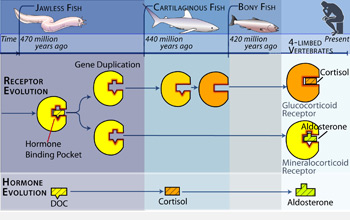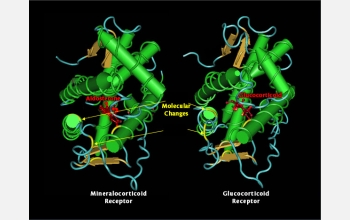All Images
News Release 06-059
New Key Fits Old Lock
Researchers document step-by-step genetic changes affecting the structure and function of ancient proteins
This material is available primarily for archival purposes. Telephone numbers or other contact information may be out of date; please see current contact information at media contacts.

Scientists recently demonstrated how an ancient hormone receptor duplicated to form two specific hormonal regulation systems. Through genetic changes, one of the duplicated receptors became specific for cortisol. The other receptor surprisingly bound to aldosterone, a hormone which appeared millions of years later when four-limbed vertebrates developed the ability to produce it. Aldosterone is similarly shaped to the more ancient deoxycorticosterone (DOC), explaining the receptor's preexisting ability to bind with it.
Credit: Nicolle Rager Fuller, National Science Foundation
Download the high-resolution JPG version of the image. (330 KB)
Use your mouse to right-click (Mac users may need to Ctrl-click) the link above and choose the option that will save the file or target to your computer.

The molecular structure of two hormone receptors is shown. Recently, a team of University of Oregon researchers led by Joseph Thornton found that two mutations were sufficient to explain their hormone binding specificity.
Credit: Jamie Bridgham, University of Oregon
Download the high-resolution JPG version of the image. (100 KB)
Use your mouse to right-click (Mac users may need to Ctrl-click) the link above and choose the option that will save the file or target to your computer.


